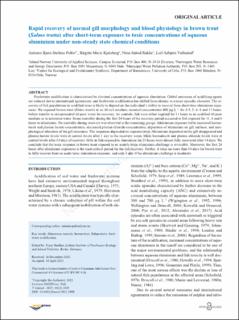| dc.contributor.author | Poleo, Antonio | |
| dc.contributor.author | Kjelsberg, Birgitte Marie | |
| dc.contributor.author | Rukke, Nina Alstad | |
| dc.contributor.author | Vøllestad, Leif Asbjørn | |
| dc.date.accessioned | 2021-11-25T08:24:07Z | |
| dc.date.available | 2021-11-25T08:24:07Z | |
| dc.date.created | 2021-07-12T14:55:10Z | |
| dc.date.issued | 2021 | |
| dc.identifier.citation | Journal of Limnology. 2021, 80 (2), 1-15. | en_US |
| dc.identifier.issn | 1129-5767 | |
| dc.identifier.uri | https://hdl.handle.net/11250/2831396 | |
| dc.description.abstract | Freshwater acidification is characterised by elevated concentrations of aqueous aluminium. Global emissions of acidifying agents are reduced due to international agreements, and freshwater acidification has shifted from chronic to a more episodic character. The recovery of fish populations in acidified areas is likely to depend on the individual’s ability to recover from short-time aluminium exposures. We exposed brown trout (Salmo trutta) to an Al-rich medium, nominal concentration 600 µg L–1, for 0.5, 2, 6, 8 and 11 hours, before transfer to circumneutral Al-poor water for recovery. As controls, fish were either exposed for 11 hours to an acidified Al-poor medium or to untreated water. Some mortality during the first 24 hours of the recovery period occurred in fish exposed for 11, 8 and 6 hours to aluminium. No mortality during recovery was observed in the remaining groups. Aluminium exposure led to increased haematocrit and plasma lactate concentration, decreased plasma chloride concentration, deposition of aluminium on gill surfaces, and morphological alteration of the gill structures. The responses depended on exposure time. Aluminium deposited on the gill disappeared and plasma lactate levels were at control levels after 1 day in the recovery water, while haematocrit and plasma chloride levels were at control levels after 14 days of recovery. Gills in fish exposed to aluminium for 11 hours were almost fully recovered after 14 days. We conclude that the toxic response in brown trout exposed to an acutely toxic aluminium challenge is reversible. Moreover, the first 24 hours after aluminium exposures is the most critical period for the fish recovery. Further, it takes no more than 14 days for brown trout to fully recover from an acute toxic aluminium exposure, and only 1 day if the aluminium challenge is moderate. | en_US |
| dc.language.iso | eng | en_US |
| dc.rights | Navngivelse-Ikkekommersiell 4.0 Internasjonal | * |
| dc.rights.uri | http://creativecommons.org/licenses/by-nc/4.0/deed.no | * |
| dc.title | Rapid recovery of normal gill morphology and blood physiology in brown trout (Salmo trutta) after short-term exposure to toxic concentrations of aqueous aluminium under non-steady state chemical conditions | en_US |
| dc.type | Peer reviewed | en_US |
| dc.type | Journal article | en_US |
| dc.description.version | publishedVersion | en_US |
| dc.source.pagenumber | 1-15 | en_US |
| dc.source.volume | 80 | en_US |
| dc.source.journal | Journal of Limnology | en_US |
| dc.source.issue | 2 | en_US |
| dc.identifier.doi | 10.4081/JLIMNOL.2021.2000 | |
| dc.identifier.cristin | 1921519 | |
| cristin.ispublished | true | |
| cristin.fulltext | original | |
| cristin.qualitycode | 1 | |

